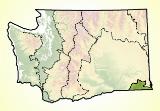 © Pete Saloutos/Panoramic Images (Washington Title Image Large)
© Pete Saloutos/Panoramic Images (Washington Title Image Large)

Blue Mountains: People in the Ecoregion
The Blue Mountains have been inhabited by humans for at least 12,000 years. The ecoregion is an ancestral home for the Nez Perce people (Nimi'ipuu), renowned across the West as horse breeders and traders. Bands camped along river bottoms in winter and left seasonally to hunt bison on the Montana high plains.
The first rush of Euro-Americans came to the Blue Mountains in search of gold in the 1860s. The hydraulic and hardrock mining that followed scoured and poisoned parts of the landscape. Mining opened the region to subsequent settlement. In the late 1800s, ranching became a predominant livelihood.
Roughly two-thirds of the region is in public ownership. The Umatilla Forest holds more than half the ecoregion’s lands. More than 111,000 acres of it in Washington is the Wenaha-Tucannon Wilderness, which straddles the Washington-Oregon border.
The state of Washington manages more than 32,000 acres, including the Asotin Wildlife Area, a major elk calving range, and the Chief Joseph and William T. Wooten Wildlife Areas, both of which contain important riparian areas.
Many of the river valley bottoms in the Blue Mountains are privately owned and used for ranching and forage crop production.
Activities such as hunting, fishing, snowmobiling and skiing make this sparsely populated ecoregion increasingly popular. It faces growing pressures from low-density vacation home development.
For details of this ecoregion within Washington, click a subheading in the left column.
View the more general description of this ecoregion in North America



